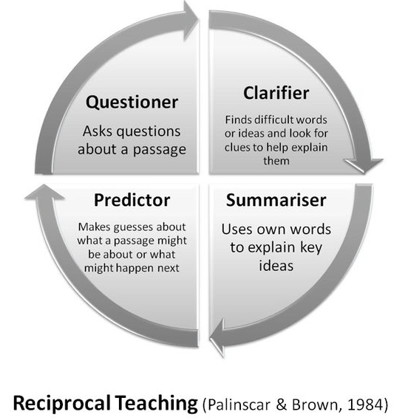Effective Strategies for Improving Reading Comprehension in English Language Learners
Many students possess good phonics skills, enabling them to sound out words effortlessly. However, they may struggle with reading comprehension, which involves understanding the meaning behind the words. This issue can lead to a frustrating learning experience and hinder academic progress. In this blog post, we'll explore some of the most effective ways to help English Language Learners (ELLs) become better readers, improve their understanding of English, and boost their academic success. One of the most important strategies is teaching academic vocabulary in a meaningful context. However, it is equally important to select vocabulary carefully and pay attention to the mid-frequency level words. We'll also discuss other research-based strategies such as providing explicit comprehension instruction and modeling, using graphic organizers, making connections to prior knowledge, teaching metacognitive strategies, and using visual aids to scaffold new information.

Teach vocabulary in a meaningful context.
Research shows that learning academic vocabulary is essential for reading comprehension in English language learners (ELLs) (Baumann, Kame'enui, & Ash, 2003). One way to teach academic vocabulary is to provide meaningful contexts for the words. Teachers can use graphic organizers to help ELLs identify and categorize new vocabulary words. They can also engage in discussions with ELLs that require them to use the new words in context.
To help students benefit from this strategy, teachers can ask students to use the new words in writing or speaking activities. For example, students can write sentences or short paragraphs that include the new words. They can also present information about a topic that requires them to use the new words in context.
One of the most effective ways to teach vocabulary to ELLs is to use academic vocabulary in a meaningful context. However, it is equally important to select vocabulary carefully and pay attention to the mid-frequency level words. Mid-frequency words are words identified as a large group of words (about 4,000) that are less frequently used but that most native speakers know by about 4th-5th grade. These words are often difficult for ELLs to learn because they are less frequent and there are so many of them. Many times ELL students hear the high-frequency words and learn them first, but the mid-frequency level words are important to explicitly teach because they are very useful and sometimes overlooked in favor of teaching the "academic words" that can actually be less useful in the future.
To help build mid-frequency vocabulary, a teacher/parent could provide ELLs with a list of mid-frequency words, such as "distract," "overwhelm," and "grasp," and ask them to find the words in the text they are reading. The teacher/parent could then ask the students to use the words in a sentence or provide a definition of the words. This strategy not only helps ELLs learn new words, but also helps them understand how these words are used in context. It is important that students have opportunities for both input and output with new words!
Provide explicit comprehension instruction and modeling.
Explicit comprehension instruction and modeling can help ELLs improve their reading comprehension. This includes strategies such as summarizing, predicting, questioning, and monitoring comprehension. A teacher/parent can model these strategies by thinking out loud while reading a text and demonstrating how to use these strategies to better understand the text.
Some specific ways parents/teachers can provide support for improved reading comprehension is:
- Encourage them to ask questions about a text including prompting them to ask "who, what, when, where, why, and how" questions, encouraging them to make predictions about what might happen next, and asking them to clarify confusing parts of the text.
Encourage them to make connections to prior knowledge because it helps students activate their existing schemata (mental frameworks or structures) related to the topic, which can aid in comprehension and memory. When students engage their schemata, it is like adding information to a folder in the brain they already had on that specific topic. Without activating prior knowledge, students may struggle to understand or retain new information.
- Encourage them to make predictions. Predicting is useful to students because it helps them engage with the text and make connections between what they are reading and their prior knowledge. Even if their predictions are not correct, it still helps them develop their metacognitive awareness and comprehension skills.
- Think-Alouds: This strategy involves the teacher/parent verbalizing their own thinking process as they read a text. By explicitly modeling their thought process, the teacher/parent helps students learn how to engage in active reading and develop comprehension strategies.
Research has shown that think-alouds can be an effective strategy for improving reading comprehension in ELLs (Zhang & Guo, 2018). To use think-alouds, the teacher/parent can select a text, and read it aloud while verbalizing their thoughts. This can include asking questions about the text, making connections to prior knowledge, and predicting what might happen next. By modeling these strategies, the teacher/parent can help students develop their own metacognitive awareness and comprehension skills. The outcome of using think-alouds is improved comprehension skills, as well as increased awareness of the thinking process required for successful reading.
Use graphic organizers for summarizing and organizing information.
Graphic organizers are a powerful tool for helping ELLs summarize and organize information from a text. Studies have shown that the use of graphic organizers can significantly improve reading comprehension and recall (Robinson & Katayama, 2012).
Here are three specific graphic organizers that parents/teachers can use to aid in summarizing and organizing information:
 1. KWL Chart: A KWL chart is a three-column chart that helps students organize their thinking about a topic. The K stands for "What I Know," the W stands for "What I Want to Know," and the L stands for "What I Learned." Using a KWL chart can help students activate their prior knowledge about a topic, generate questions to guide their reading, and summarize what they have learned.
1. KWL Chart: A KWL chart is a three-column chart that helps students organize their thinking about a topic. The K stands for "What I Know," the W stands for "What I Want to Know," and the L stands for "What I Learned." Using a KWL chart can help students activate their prior knowledge about a topic, generate questions to guide their reading, and summarize what they have learned.
2. Venn Diagram: A Venn diagram is a graphic organizer that shows the relationships between two or more sets of information. This can be especially useful for ELLs who are learning about new concepts or vocabulary. By comparing and contrasting different ideas, students can better understand the connections between them and identify key similarities and differences.
3. Concept Map: A concept map is a visual representation of a topic that shows how different ideas are related to each other. This can be useful for ELLs who are struggling to understand complex concepts or texts. By breaking down a topic into its component parts and showing the relationships between them, students can gain a deeper understanding of the material and better organize their thoughts.
To use these graphic organizers with ELL students, teachers/parents can first model how to use the organizer, and then provide guided practice with the group. For example, a teacher/parent could provide an ELL student with a KWL chart and guide them through the process of filling it out. They could also model how to use a Venn diagram or concept map, and provide opportunities for the student to practice using them with different texts.
In summary, graphic organizers are a valuable tool for helping ELLs improve their reading comprehension and recall. By providing a visual representation of information and encouraging critical thinking, graphic organizers can help students organize their thoughts and better understand the relationships between different pieces of information.
Use text-to-self, text-to-text, and text-to-world connections.
Text-to-self, text-to-text, and text-to-world connections are three types of connections that ELLs can make when reading to help them understand and relate to the text on a deeper level.
Text-to-self connections involve making connections between the text and the reader's own life experiences. For example, in the classic children's story "The Cat in the Hat" by Dr. Seuss, a reader might make a text-to-self connection by relating to the characters' feelings of excitement and nervousness when they are left alone at home with nothing to do.
Text-to-text connections involve making connections between the text being read and other texts the reader has encountered. For example, when reading "The Cat in the Hat", a reader might make a text-to-text connection by recognizing the rhyming patterns and wordplay that are common in other Dr. Seuss books they have read.
Text-to-world connections involve making connections between the text and events or phenomena in the wider world. For example, a reader of "The Cat in the Hat" might make a text-to-world connection by thinking about how the story reflects the importance of following rules and being responsible, concepts that are important in their own life and in society as a whole.
Research has shown that making text-to-self, text-to-text, and text-to-world connections can help ELLs to engage with the text and deepen their comprehension (Mokhtari & Reichard, 2002).
To help students make these connections, teachers/parents can model the process by thinking aloud and sharing their own connections, provide prompts and guiding questions to prompt students' thinking, and encourage students to share their own connections with the class.
Here are some examples of prompts that can be used to help students make text-to-self, text-to-text, and text-to-world connections:
Text-to-Self: How does the story remind you of something that has happened to you? How would you have felt if you were in the same situation as the character? What would you have done differently?
Text-to-Text: How does this story compare to another story you have read? What similarities and differences do you notice? How do the characters in this story compare to the characters in another story?
Text-to-World: How does the story relate to current events in the world? What connections can you make between the story and your own community or culture? What issues raised in the story are relevant to society today?
Teach and encourage metacognitive strategies such as self-questioning, summarizing, predicting, and monitoring comprehension.
Metacognitive strategies such as self-questioning, summarizing, predicting, and monitoring comprehension can help ELLs become more aware of their own thinking processes while reading.
Research has consistently shown that metacognitive awareness while reading is a key indicator of reading comprehension success. In a meta-analysis of 58 studies on metacognitive strategy instruction, researchers found that students who received metacognitive strategy instruction showed significant gains in reading comprehension, with the greatest benefits for struggling readers (Vidal-Abarca et al., 2014).
To build metacognitive strategies, a teacher/parent could ask students to think about what they are reading and ask themselves questions such as "Does this make sense?" or "What do I think will happen next?" This encourages the student to actively engage with the text and monitor their own comprehension. Similarly, summarizing and predicting require the student to think about the text and organize information in their own words, which can help them remember what they have read and better understand the text.
Monitoring comprehension involves identifying when one has not understood something in a text and taking action to address the issue. For instance, if a student is reading and comes across a word they do not know, they can use contextual clues to try and understand the meaning. If they are still unsure, they can ask the teacher/parent for help or look up the word in a dictionary. This type of self-monitoring can help language learners become more independent readers and develop their critical thinking skills.
By explicitly teaching and encouraging the use of metacognitive strategies, teachers/parents can help students become more active and engaged readers. This, in turn, can improve their reading comprehension and academic achievement.
Metacognitive Reading Strategy Spotlight:
Reciprocal Teaching
Reciprocal teaching: Reciprocal Teaching (RT) is a research-based strategy that incorporates metacognitive strategies into reading instruction. It involves a back-and-forth dialogue between the teacher/parent and student in which they take turns leading discussions on the text. The teacher/parent models the use of metacognitive strategies by asking questions about the text, summarizing key points, making predictions, and clarifying misunderstandings. Then, the student takes on the role of the teacher/parent, leading the discussion and using metacognitive strategies to support their understanding of the text.
Reciprocal teaching has been shown to be an effective strategy for improving reading comprehension in English language learners. A study of 95 middle school ELLs found that students who received reciprocal teaching instruction made significant gains in reading comprehension, outperforming a control group that did not receive the instruction (Hudson et al., 2005).
By using reciprocal teaching, teachers/parents can help students develop their metacognitive skills and become more active and engaged readers.

In closing, NSEO tutoring services prioritize reading comprehension skills and stay current with the latest research to support student achievement in all areas, including vocabulary acquisition and comprehension strategies. To effectively teach academic vocabulary to English language learners, teachers and parents can use meaningful contexts, pay attention to mid-frequency words, and encourage both input and output activities. For improved comprehension, explicit instruction and modeling of comprehension strategies, such as summarizing, predicting, questioning, and monitoring, can be useful, as can encouraging connections to prior knowledge and using graphic organizers like KWL charts, Venn diagrams, and concept maps. By providing these resources and strategies, NSEO and parents can help English language learners become confident, capable readers who are ready to excel academically and beyond.




